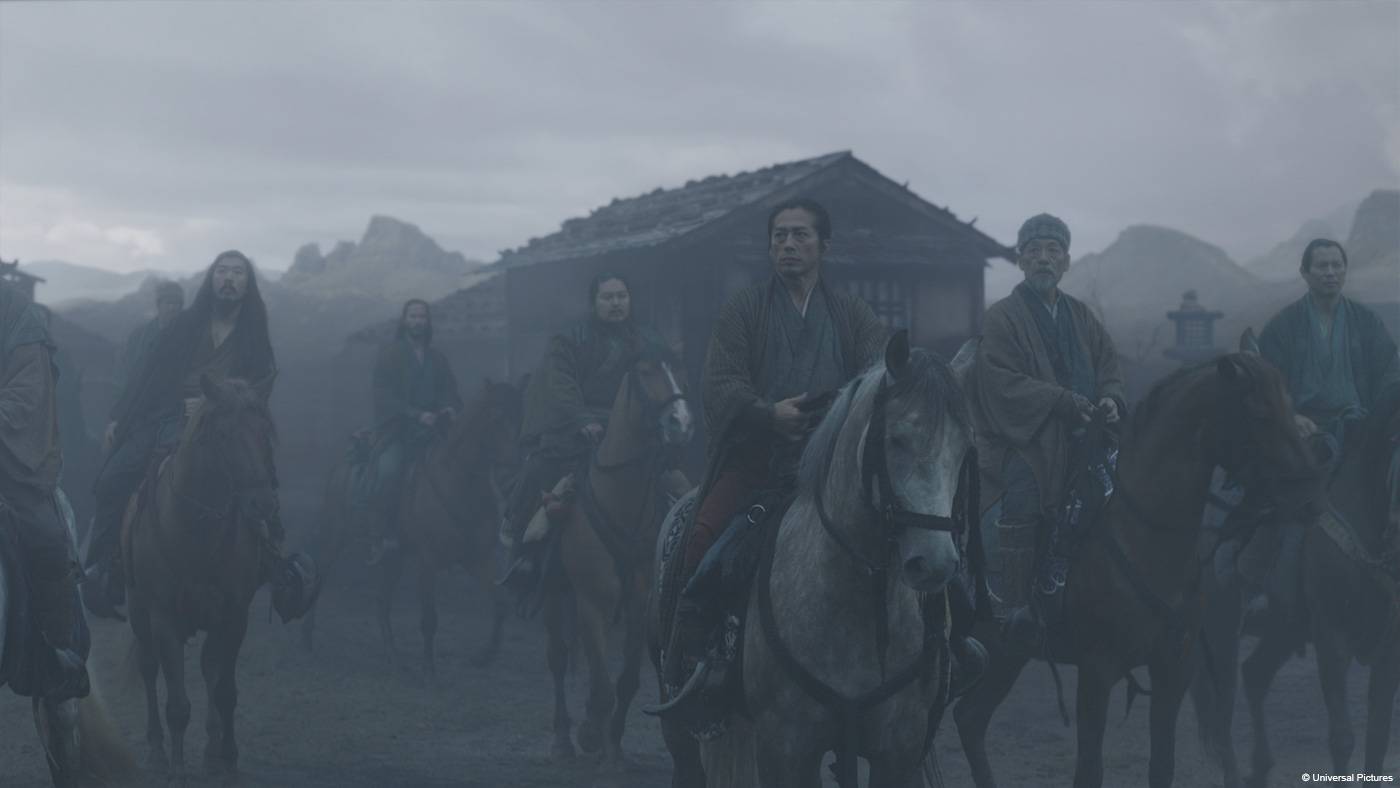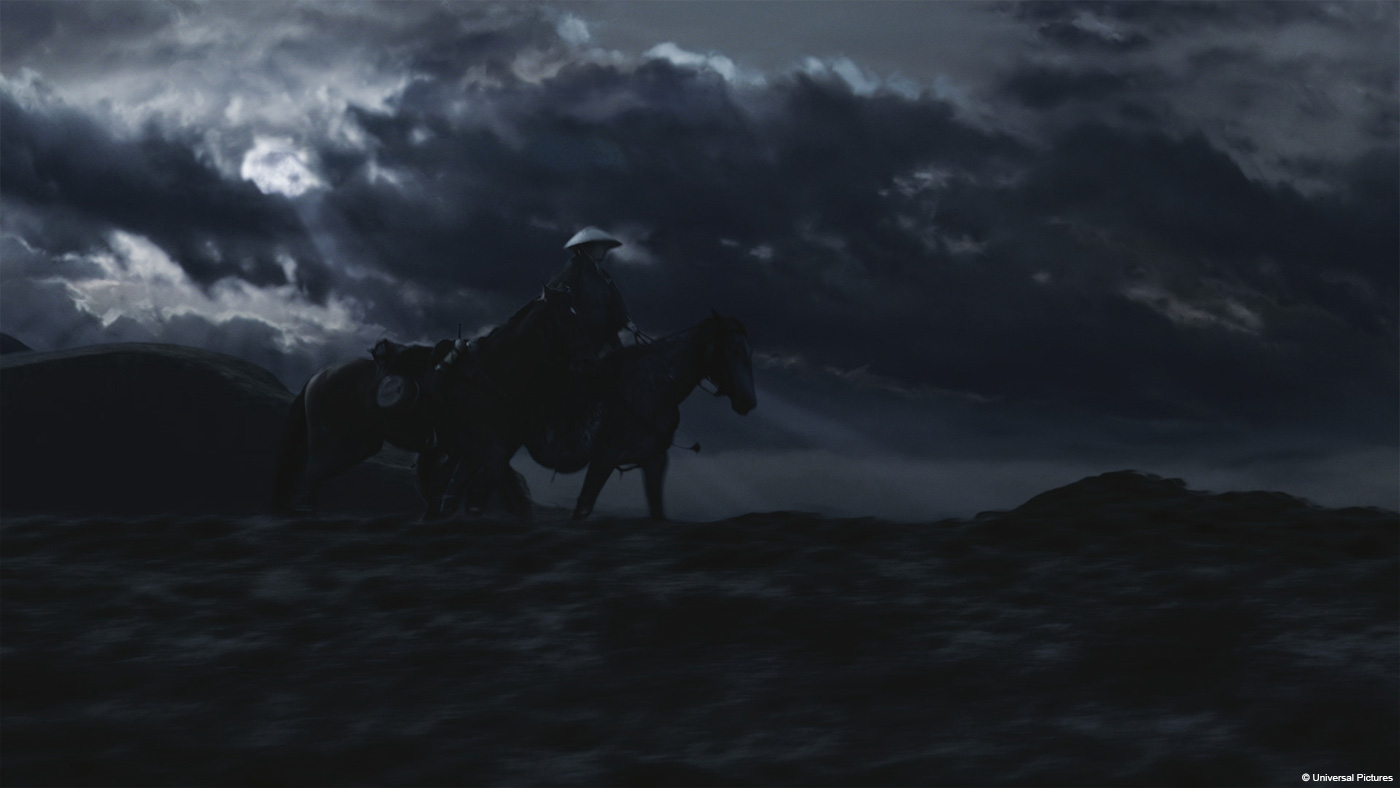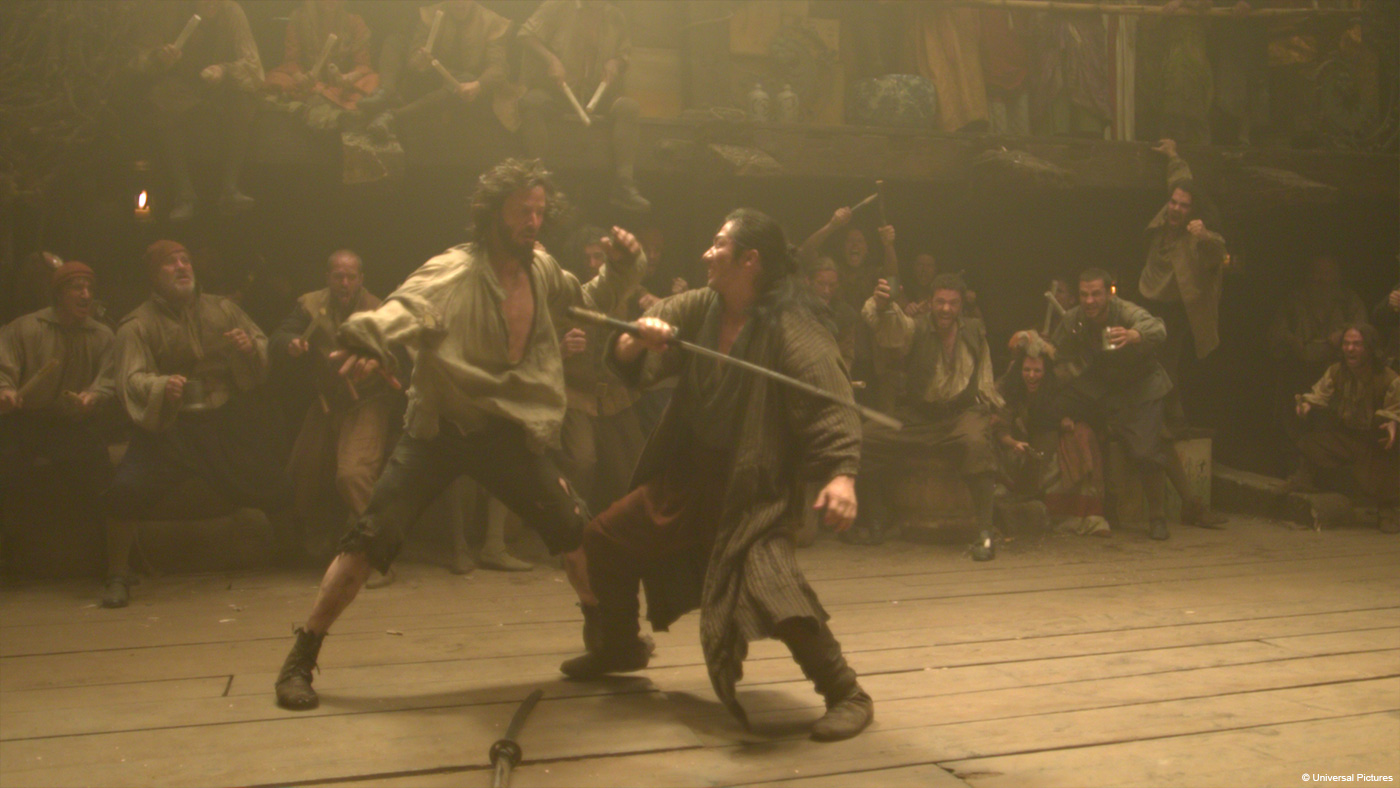Few weeks ago, Rudi Holzapfel explained the work of Baseblack on JACK RYAN: SHADOW RECRUIT. He is back to tell us about 47 RONIN.
How did Baseblack get involved on this show?
Tim Burke made introductions to Christian Manz and got the work in.
How was your collaboration with director Carl Rinsch?
We didn’t get direct feedback, it was usually filtered through Christian Manz.
How did you work with Production VFX Supervisor Christian Manz?
Christian is a very experienced supervisor, who had very good ideas about what was required and often times did simple layouts for the bigger matte paintings or changes to images. We usually met once or twice a week in the screening rooms at Baseblack to present work and talk about specific feedback.
What was your role on this project?
I was VFX Supervisor for Baseblack.
How did you approach the set extensions for the villages of Ako and Uetsu?
The set extensions for the Ako village were created as textured models by Framestore, the lead vendor on the show. They had much more elaborate shots involving Ako village, so we could just pick up their layouts and make them work for our pipeline and shots. We often ended up rendering a first lighting pass, put them through matte paintings and re-project them in 3D or Nuke depending on the complexity of the camera. The biggest challenges for the Ako village sequence were on the one hand the on-set rain which we had to emulate in order to hide our set extensions behind them, on the other hand the fact that some of the exteriors had been shot in the studio with very particular light, which we ended up changing in some of the wider shots to match with the other shots.
The Uetsu village was a different scenario. We had various shots, from a big opener of the ronins arriving at the scene after the village had been raided by Kira’s soldiers, to various closeups, some of them set extensions, some of them fully CG environments with nothing but a bluescreen behind the actors to work with. We again started with a grey scale model to create a simple layout of the village – done by Robert Hesketh – and once that was somewhat approved in its basic shape and size, we textured it, gave it to matte paintings and eventually re-projected it in Nuke for the wide opener. Environment effects, a lot of smoke in the burned-down village, a change of the mountains behind the village, a new sky DMP etc. were added in Nuke to turn Scotland into Japan. For the closer shots in the village we build fully-textured models of the houses that were lit in 3D; the sky and the grounds with puddles, mud, rocks and some characteristic lanterns came from matte paintings to add to the shots. Chris Petts in 3D and Charlotte Tyson for matte paintings signed responsible for these shots. Especially for the closer shots in the village, Joss Flores and Tim Young created some beautiful work for Baseblack.
What indications and references did you received from the director for these environments?
We had one reference of the set from Carl Rinsch for Uetsu village, the rest was research predominantly by Charlotte again, to give the houses and muddy streets an authentic look.
What were the real size of these sets?
The sets were proper size sets, but as is often the case, they contained only one street and/or square, that was used from different angles to create a multitude of views and shots.
Can you tell us more about the creation for the Kira’s fortress landscape?
The landscape of the approach to Kira’s fortress went through a number of changes as the story and with it the amount of magical content of the film evolved. We initially started with very craggy, imposing and almost dangerous and dark looking mountains and finally ended up with a more realistic, but still alpine and somewhat mythical look. The multicoloured sky added a final element of foreboding to the shots. In order to make this work, we had to heavily regrade the initial shot, which was shot in autumn and needed to look wintry-white in order to match with the surrounding shots. We threw away a bit more than half of the plate and put the new landscape in the background, added drifting snow in various layers from very close to camera up to several miles in the distance and also regarded the actors to fit in with the new lighting. As all this was created as a « stereo » or 3D film, special attention had to be paid to the depth in the shot. Since there was no reference with regard to the amount of depth in the plate we had to play around a lot until everyone was satisfied.
How did you handle the CG snow?
Our FX specialist Robert Hesketh created the snow in all the scenes. In general, Wesley Froud in matchmove created the scenes with simple geometry and various cameras for a whole scene, which would represent a number of shots. Robert then created simulations for the CG snow that had at least the simple geometry in it to create some boundaries. We developed a template script in Nuke that allowed us to create simple depth geometry for the actors so that they could move through the snow in 3D space which was essential for the 3D viewing.
Can you tell us more about the creation of the various CG weapons?
These were normally simple 3D weapons, arrows, some quite fullscreen, some incidental to enhance the battle experience, swords or knives that would sometimes just be wielded, sometimes get stuck in the floor, or slice into an actor, in which case we also added a bit of CG blood. Normally this was just bread-and-butter vfx, but there were a few scenes where it turned out to be more difficult.
For one, the actors didn’t make the right hand movements or didn’t have their hands face in the right direction so we had to repaint or warp things to make them fit, sometimes their movements were so quick that it was impossible to see the weapons without a good deal of cheating. In those cases the weapons ended up being bigger than normal and usually had a lot of highlights reflected in them to make them stand out in the shots. More by accident than planning we ended up having two compositors, Stephanie Kelly and Claudio Bassi put most of the weapons beautifully into the shots, especially for the Dutch Island scene, the fight between Kai and Oshi, were Kai’s sword is in fully CG in quite a few of the shots, sometimes both swords are.
Can you tell us more about your work for the tournament at Ako Village?
I would call this « gardening » more than anything else. Japanese gardens – and apparently tournament grounds – are kept immaculate it seems. When you have a film crew of 100 or more, extras, actors all move around on a set like that, things inevitably get kicked around a bit. We ended up cleaning up 50 shots give or take, were borders between grass and gravel had to be cleaned up, grass made greener, little bluescreens cleaned up, skies matched, bugs painted out, camera shadows cleaned up, pebbles evened out, …. In the end we had a sequence that would cut nicely together. It was a number of junior compositors who ended up doing most of the work, with Pietro Coco and Konstantinos Panagiotopoulos probably picking up the most of it.
What was the biggest challenge on this project and how did you achieve it?
Although some of us had worked on a 3D film before (DREDD 3D), it was the complexity of the pipeline that was difficult in the beginning. It wasn’t just that you always had two eyes per shot to work on, one of them the « hero » eye, but they had to be matched in colour (no two cameras and lenses are alike) and vertical alignment (depth in a stereo film is expressed as a difference in the horizontal between both eyes, but not in the vertical) and production also wanted every shot colour-matched the editor’s first grade. For a small facility to double in size and build a stable pipeline was a challenge. We ended up relying on the expertise of senior compositor and 2D supervisor Martin Ofori, who had joined us from the stereo conversion team at Prime Focus. He developed several tools and template scripts that proved invaluable in the process of the next 21 months.
Was there a shot or a sequence that prevented you from sleep?
No, not really. The most difficult sequence was probably the Uetsu-village sequence and it ended up creating a few very late nights, but they weren’t totally sleepless thanks to senior compositor Joss Flores who took the lead on this difficult scene.
How long did you work on this film?
21 months.
How many shots did you do?
About 315 give or take.
What was the size of your team?
Because of the length of the project and not a steady stream of turnover due to reshoots and recuts, the team size greatly varied, probably between 10 and nearly 30 at peak times.
A big thanks for your time.
// WANT TO KNOW MORE?
– Baseblack: Official website of Baseblack.
© Vincent Frei – The Art of VFX – 2014





























